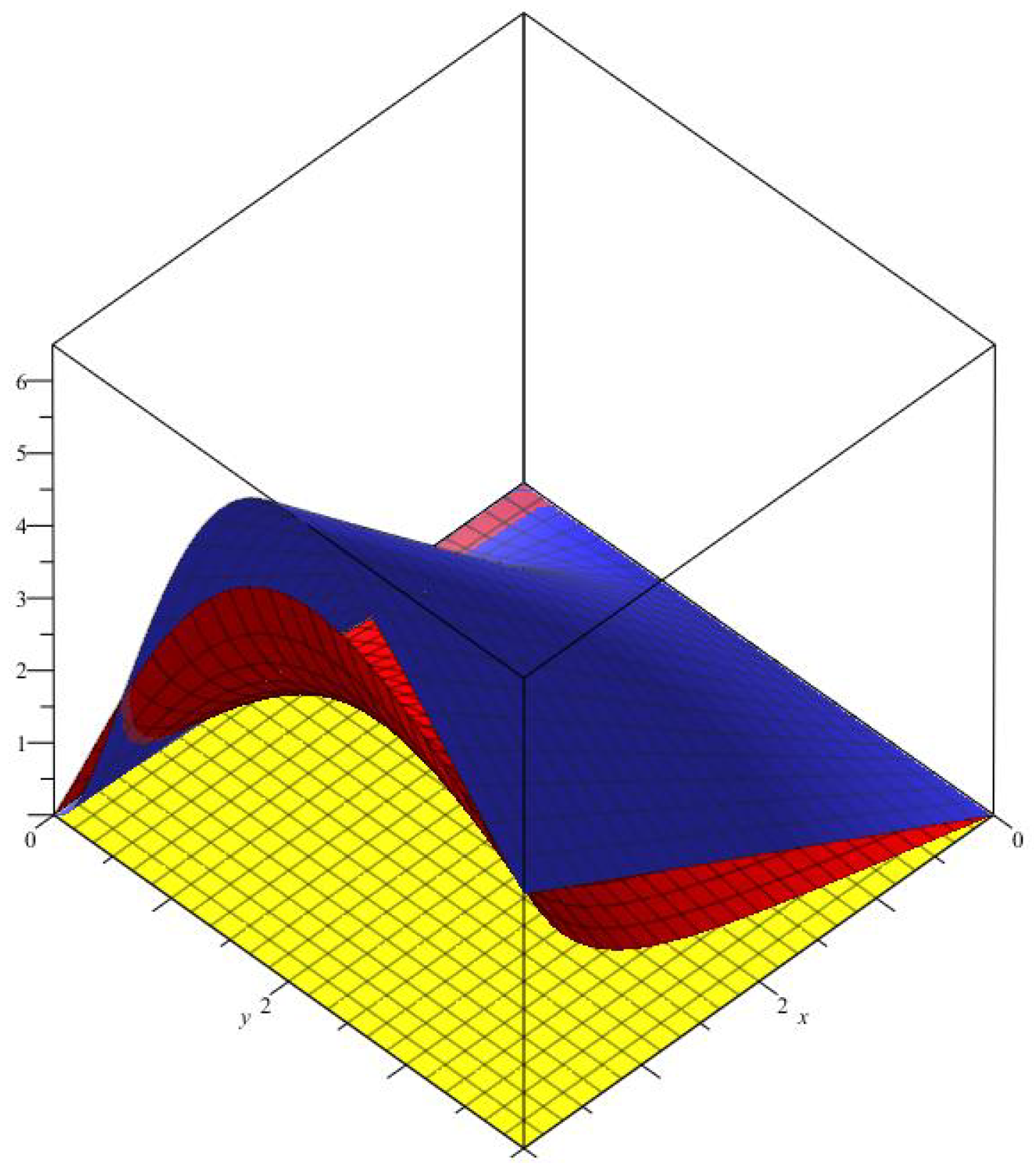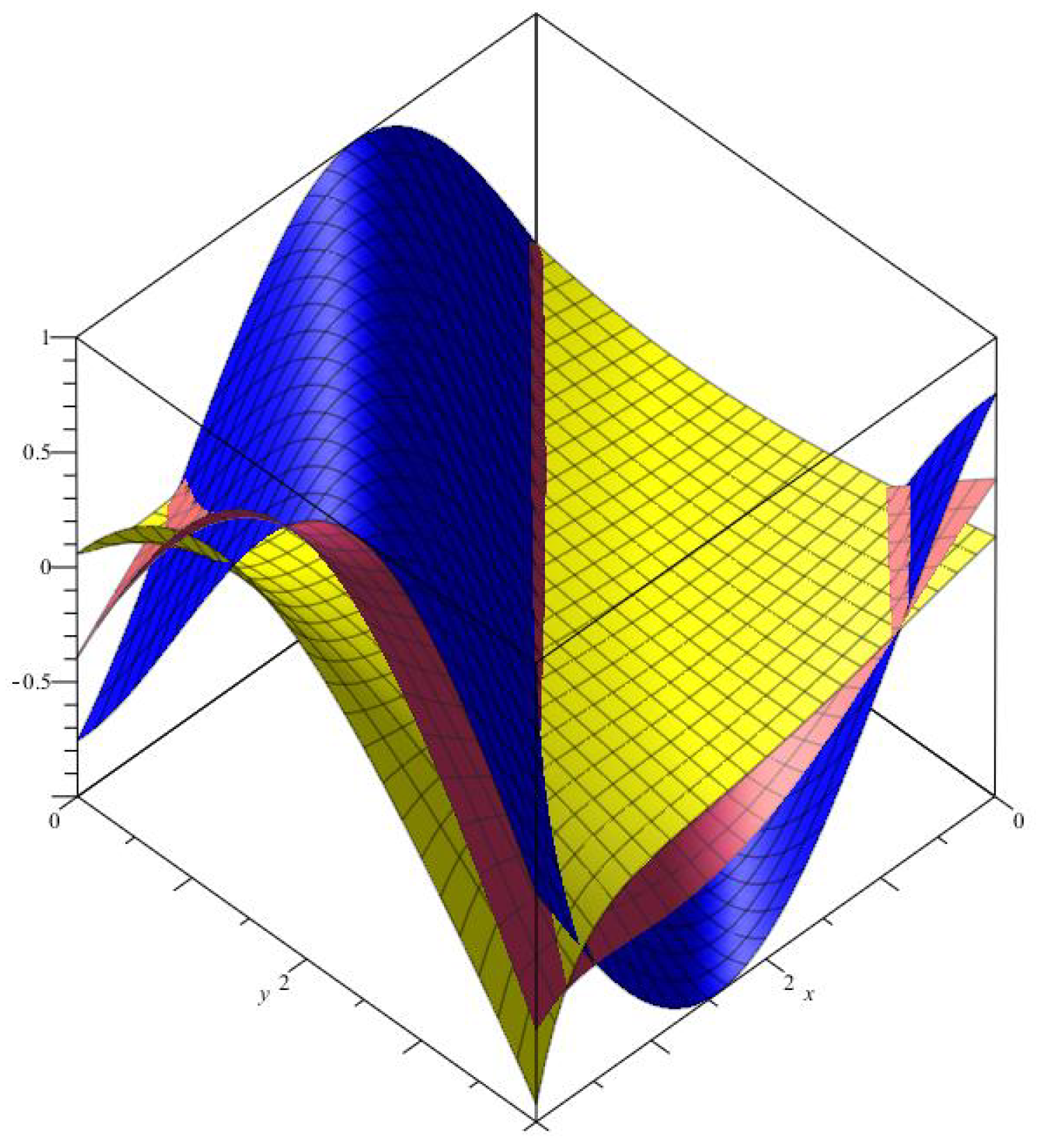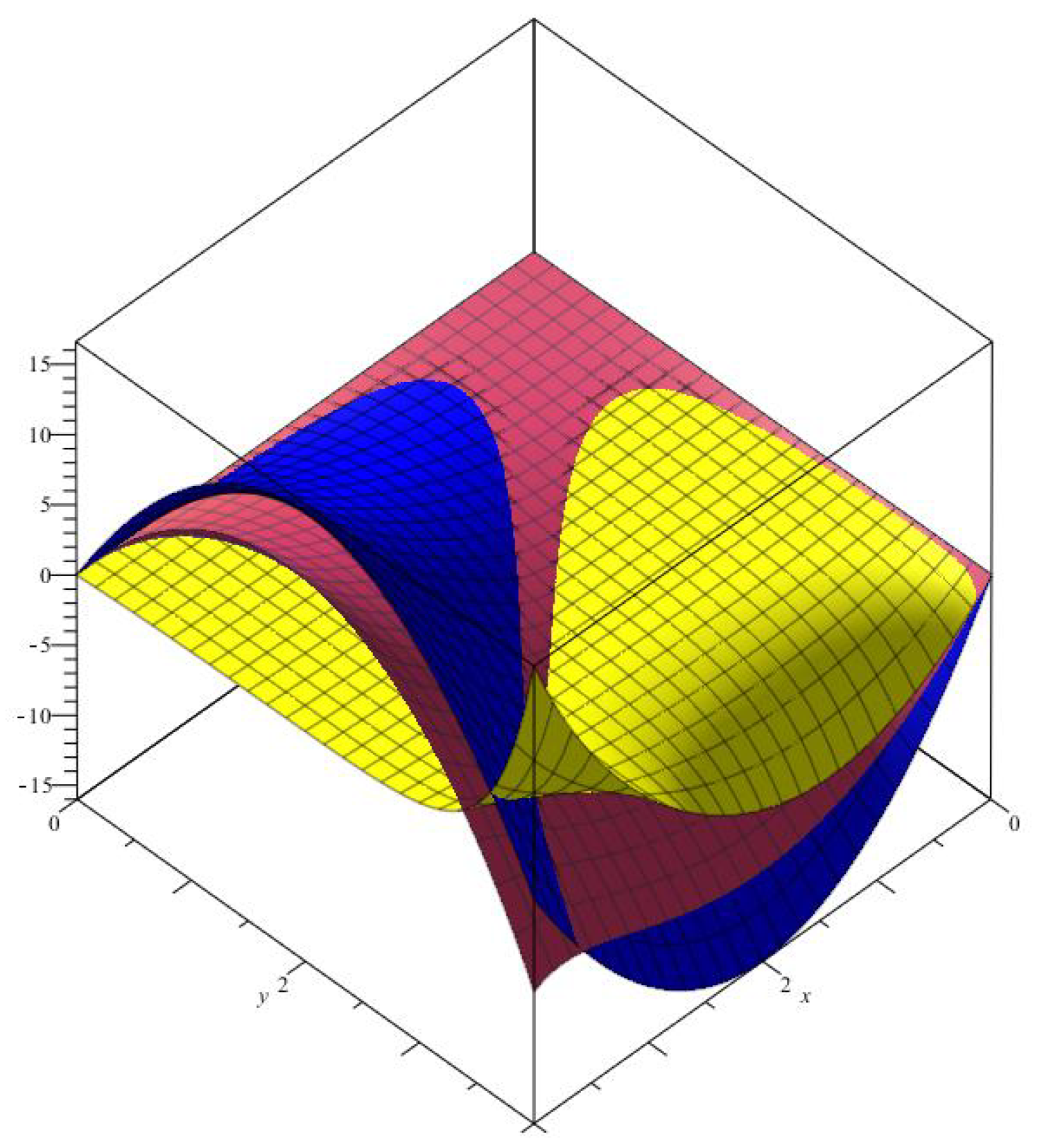1. Introduction
The study provides a comprehensive examination of the theory and applications of mathematical operators, aligning with the content areas of Mathematics, Engineering, Physics, and Computer Science. The investigation of the convergence properties of Chlodovsky type Bernstein operators using the Korovkin-type theorem is directly part of mathematical analysis and approximation theory. Such studies yield significant results applicable to fields like mathematical modeling and optimization. Furthermore, the optimization of convergence rates of operators through system control contributes to the more efficient and stable management of systems within control engineering. Lastly, visual illustrations created using Maple demonstrate the convergence rates of operators on specific functions, contributing to modeling and simulation techniques used in computer science. In this context, our work offers a valuable addition to the scope of the journal Symmetry.
Approximation theory is rapidly emerging as an essential tool, extending its influence beyond classical domains to other mathematical areas such as differential equations, orthogonal polynomials, and geometric design. Following the introduction of Korovkin’s renowned theorem in 1950, the topic of approximating functions using linear positive operators has become an increasingly significant focus within approximation theory. A wealth of literature has been produced on this subject [
1,
2,
10,
12,
14,
15,
23,
24,
31,
32].
In recent years, particularly over the last twenty years, the role of q-calculus in approximation theory has been thoroughly investigated. The initial work on Bernstein polynomials derived from q-integers was conducted by Lupaş [
6]. His findings indicated that q-Bernstein polynomials can provide superior approximations compared to classical methods when an appropriate choice of q is made. This discovery has encouraged numerous researchers to develop q-generalizations of various operators and to explore their approximation properties further. Numerous studies have contributed to this field [
3,
7,
8,
13].
Lately, Mursaleen et al. have concentrated on utilizing
calculus for approximations through linear positive operators, introducing the
analogues of Bernstein operators [
20,
21]. They analyzed the uniform convergence of these operators and determined their rates of convergence. For additional recent studies related to
operators, readers can refer to [
17,
18,
19,
26,
27].
The main motivation behind this study is that, to the authors’ knowledge, there have been no investigations into approximating two-variable operators using
calculus thus far. In this context, we introduce two dimensional Chlodovsky type Bernstein operators based on
integers. We investigate the approximation properties of our newly defined operators with the aid of the Korovkin-type theorem. Furthermore, we delve into the local approximation characteristics and determine the rates of convergence through the modulus of continuity and a Lipschitz type maximal function. A Voronovskaja type theorem relevant to these operators is also presented. Another significant aim of this research is to examine the weighted approximation properties of our operators in the first quadrant of
, specifically within the range of
. To achieve these results, we intend to apply a weighted Korovkin-type theorem. We will begin by revisiting some definitions and notations pertinent to the concept of (p, q)-calculus. The (p, q)-integer associated with a given number n is defined as
The
factorial
and the
binomial coefficients are defined as:
and
Further, the
binomial expansions are given as
and
Further information related to
calculus can be found in [
25,
28].
2. Construction of the Operators
Recently, Ansari and Karaisa [
16] have defined and studied
analogue of Chlodovsky operators as follows:
where
For
, we define Chlodovsky type two dimensional Bernstein operator based on
integers as follows:
for all
,
with
and
. Here
and
be increasing unbounded sequences of positive real numbers such that
Also, the basis elements are
We require the following lemmas to establish our main results.
From Lemma 1, we have following:
Lemma 2.
Using Lemma 2 and by linearity of , we have
Theorem 1. Let , , ,
such that . If
the sequence convergence uniformly to , on for each , where be real numbers such that , and be the space of all real valued continuous function on with the norm
Proof. Assume that the equities (
7), (
3) and (4) are holds. Then, we have
as
. From Lemma 2, we obtain
uniformly on
, where
are the test functions. By Korovkin’s theorem for functions of two variables was presented by Volkov [
29], it follows that
, uniformly on
, for each
. □
3. Rate of Convergence
In this section, we analyze the convergence rates of the operators to the function using the modulus of continuity. Furthermore, we will present a summary of the relevant notations and definitions concerning the modulus of continuity and Peetre’s K-functional for bivariate real-valued functions.
For a function
, the complete modulus of continuity in the bivariate context is defined as follows:
for every
. Additionally, the partial moduli of continuity concerning
x and
y are defined as follows:
It is evident that they fulfill the properties of the standard modulus of continuity [
11].
For
, the Peetre-K functional [
22] is defined as follows:
where
is the space of functions of
f such that
f,
and
in
. The norm
on the space
is defined by
We now provide an estimate for the rate of convergence of the operators .
Theorem 2.
Let . For all , we have
where
Proof. By definition, the complete modulus of continuity of
, along with the linearity and positivity of our operator, allows us to express:
Using Cauchy-Scwartz inequality, from (
5) and (6), one can write following
Choosing
, for all
, we get desired the result.
□
Theorem 3.
Let , then the following inequalities satisfy
where
Proof. By definition, the partial moduli of continuity of
and the application of the Cauchy-Schwarz inequality imply that:
Consider (
5), (6) and choosing
we reach the result. □
For
and
, we define the Lipschitz class
for the bivariate case as follows:
Theorem 4.
Let . Then, for all , we have
where and defined in (8) and (9), respectively.
Proof. As
, it follows
For
and
applying the Hölder’s inequality, we get
Hence, we obtain the desired result. □
Theorem 5.
Let and . Then, we have
Proof. For
, we obtain
By applying our operator to both sides of the above equation, we deduce:
As
we have
Using the Cauchy-Schwarz inequality, we can write following
Form (
5) and (6), we get desired the result. □
Below, we obtained three-dimensional graphs illustrating the convergence rates of operators to specific functions using the Maple [
30] software.
Example 1. Figure 1 shows the optimal approximation of operators
(red), (yellow)
with , to function (blue).
Figure 1.
Convergence of two-dimensional Bernstein-Chlodowsky polynomials.
Figure 1.
Convergence of two-dimensional Bernstein-Chlodowsky polynomials.
Example 2. Figure 2 shows the optimal approximation of operators
(red),
(yellow)
with , to function (blue).
Figure 2.
Convergence of two-dimensional Bernstein-Chlodowsky polynomials.
Figure 2.
Convergence of two-dimensional Bernstein-Chlodowsky polynomials.
Example 3. Figure 3 shows the optimal approximation of operators
(red), (yellow)
with , to function (blue).
Figure 3.
Convergence of two-dimensional Bernstein-Chlodowsky polynomials.
Figure 3.
Convergence of two-dimensional Bernstein-Chlodowsky polynomials.
Theorem 6.
Let , then we have
where
Proof. Let
. Utilizing Taylor’s formula, we derive:
By applying
to both sides of the above equation, we obtain:
As
and
, one can write following
By (
5), (6), we deduce,
By the linearity
, we obtain
By (
10) and (
11), one can see that
This step completes the proof. □
Initially, we need to establish the auxiliary result found in the subsequent lemma.
Lemma 3. Let be sequences such that and as . Then, we have the following limits:
-
(i)
-
(ii)
.
Proof. (i) Using Lemma 1, we have
Then, we get
Taking the limit of both sides of the above equality as
, we can write:
(ii) Utilizing Lemma 1 along with the linearity of the operators
, we arrive at:
where
Taking the limit of both sides of
, we arrive at:
Similarly, we can show that;
By combining (
14)-(
16), we reach the desired the result. □
Now, we ready present a Voronovskaja type theorem for .
Theorem 7.
Let . Then, we have
Proof. Let
. Then, write Taylor’s formula of
f as follows:
where
and
as
.
If we apply the operator
on (
17), we obtain
Applying the limit of both sides of the above equality, we get , □
By Cauchy-Schwartz inequality, we can write the following
As
and from Lemma 3(ii)
is finite, then we have
Hence, we deduce
This step completes the proof.
4. Weighted Approximation Properties of Two Variable
Function
In this section, we investigate the convergence of the sequence of linear positive operators to a function of two variables defined within a weighted space. We also compute the rate of convergence using the weighted modulus of continuity.
Let
, and define
as the space of all functions
f defined on the real axis that satisfy
, where
is a positive constant dependent solely on
f. The subspace
of
consists of all continuous functions and is equipped with the norm:
Let
represent the subspace of all functions
for which
exists and is finite. For every
, the weighted modulus of continuity is defined as
Lemma 4.
The operators defined (2) act from to if and only if the inequality
holds for some positive constant c.
Theorem 8.
Consider the sequence of linear positive operators defined in (2). For any function and for all points , it follows that
Proof.
Again by Lemma 2, we can write following
Considering the limit of both sides of the preceding inequality as
and applying (
3) and (4), we derive
Applying weighted Korovkin theorem for two variable which presented by Gadzhiev [
4,
5], we get desired the results. □
For estimate rate of convergence, we need the following lemma.
Lemma 5.
For all , by (5), (6) and (13), one can write the following
and
Now, compute rate of convergence the operator in weighted spaces.
Theorem 9.
If then we have
, where is a constant independent of and , .
Proof. Taking into account the following inequality given in [
9], we deduce
Applying
both side above inequality and using Cauchy-Schwarz inequality, one can write following
By (
19)-(22), we obtain
Taking
, one write the following:
where
is a constant independent of
Since
for sufficiently large
we get
This step completes the proof. □







